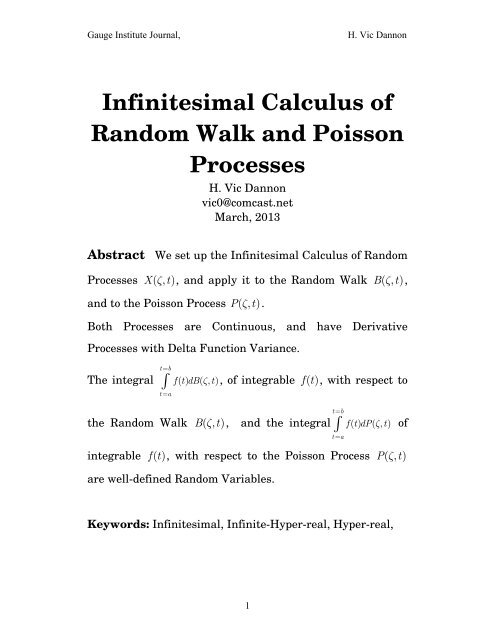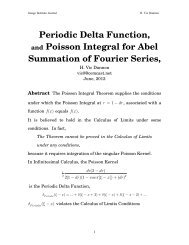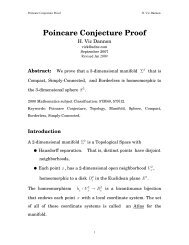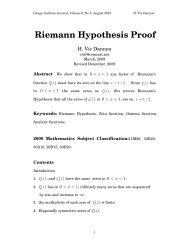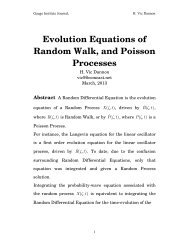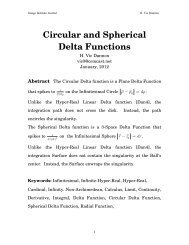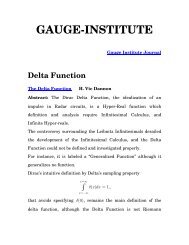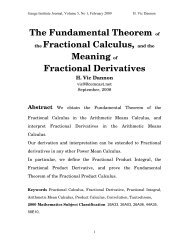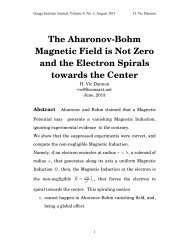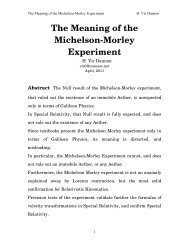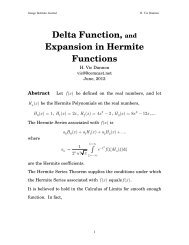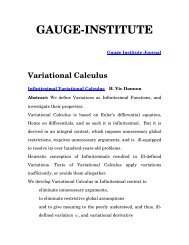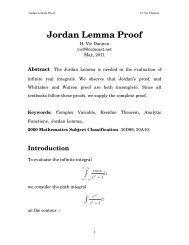Infinitesimal Calculus of Random Walk and Poisson Processes
Infinitesimal Calculus of Random Walk and Poisson Processes
Infinitesimal Calculus of Random Walk and Poisson Processes
You also want an ePaper? Increase the reach of your titles
YUMPU automatically turns print PDFs into web optimized ePapers that Google loves.
Gauge Institute Journal,<br />
H. Vic Dannon<br />
<strong>Infinitesimal</strong> <strong>Calculus</strong> <strong>of</strong><br />
<strong>R<strong>and</strong>om</strong> <strong>Walk</strong> <strong>and</strong> <strong>Poisson</strong><br />
<strong>Processes</strong><br />
H. Vic Dannon<br />
vic0@comcast.net<br />
March, 2013<br />
Abstract We set up the <strong>Infinitesimal</strong> <strong>Calculus</strong> <strong>of</strong> <strong>R<strong>and</strong>om</strong><br />
<strong>Processes</strong> X(,)<br />
ζ t , <strong>and</strong> apply it to the <strong>R<strong>and</strong>om</strong> <strong>Walk</strong> B(,)<br />
ζ t ,<br />
<strong>and</strong> to the <strong>Poisson</strong> Process P(,)<br />
ζ t .<br />
Both <strong>Processes</strong> are Continuous, <strong>and</strong> have Derivative<br />
<strong>Processes</strong> with Delta Function Variance.<br />
The integral<br />
t=<br />
b<br />
∫ ftdB () (, ζ t)<br />
, <strong>of</strong> integrable f () t , with respect to<br />
t=<br />
a<br />
the <strong>R<strong>and</strong>om</strong> <strong>Walk</strong> B(,)<br />
ζ t , <strong>and</strong> the integral ftdP () (, ζ t)<br />
<strong>of</strong><br />
t=<br />
b<br />
∫<br />
t=<br />
a<br />
integrable<br />
f () t , with respect to the <strong>Poisson</strong> Process<br />
P(,)<br />
ζ t<br />
are well-defined <strong>R<strong>and</strong>om</strong> Variables.<br />
Keywords: <strong>Infinitesimal</strong>, Infinite-Hyper-real, Hyper-real,<br />
1
Gauge Institute Journal,<br />
H. Vic Dannon<br />
<strong>Calculus</strong>, Limit, Continuity, Derivative, Integral, Delta<br />
Function, <strong>R<strong>and</strong>om</strong> Variable, <strong>R<strong>and</strong>om</strong> Process, <strong>R<strong>and</strong>om</strong><br />
Signal, Stochastic Process, Stochastic <strong>Calculus</strong>, Probability<br />
Distribution, Bernoulli <strong>R<strong>and</strong>om</strong> Variables, Binomial<br />
Distribution, Gaussian, Normal, Expectation, Variance,<br />
<strong>R<strong>and</strong>om</strong> <strong>Walk</strong>, <strong>Poisson</strong> Process<br />
2000 Mathematics Subject Classification 26E35; 26E30;<br />
26E15; 26E20; 26A06; 26A12; 03E10; 03E55; 03E17; 03H15;<br />
46S20; 97I40; 97I30.<br />
2
Gauge Institute Journal,<br />
H. Vic Dannon<br />
Contents<br />
Introduction<br />
1. Hyper-real Line<br />
2. Hyper-real Function<br />
3. Integral <strong>of</strong> a Hyper-real Function<br />
4. Delta Function<br />
5. Hyper-real <strong>R<strong>and</strong>om</strong> Variable<br />
6. Normal Distribution, <strong>and</strong> Delta Function<br />
7. Hyper-real <strong>R<strong>and</strong>om</strong> Signal X(,)<br />
ζ t<br />
8. Continuity <strong>of</strong> X(,)<br />
ζ t<br />
9. Derivative <strong>of</strong> X(,)<br />
ζ t<br />
10. <strong>R<strong>and</strong>om</strong> <strong>Walk</strong> B(,)<br />
ζ t<br />
11. <strong>R<strong>and</strong>om</strong> <strong>Walk</strong> is Continuous, has a Derivative with Delta<br />
Function Variance, <strong>and</strong><br />
Variation.<br />
t=<br />
b<br />
∫<br />
12. f () tdB(, ζ t)<br />
t=<br />
a<br />
13. <strong>Poisson</strong> Process P(,)<br />
ζ t<br />
EB [ ( ζ, t)]<br />
has unbounded<br />
14. <strong>Poisson</strong> Process is Continuous <strong>and</strong> has a Derivative with<br />
Delta Function Variance<br />
3
Gauge Institute Journal,<br />
H. Vic Dannon<br />
t=<br />
b<br />
∫<br />
15. f () tdP(, ζ t)<br />
t=<br />
a<br />
References<br />
4
Gauge Institute Journal,<br />
H. Vic Dannon<br />
Introduction<br />
0.1 <strong>Infinitesimal</strong> <strong>Calculus</strong><br />
Recently we have shown that when the Real Line is<br />
represented as the infinite dimensional space <strong>of</strong> all the<br />
Cauchy sequences <strong>of</strong> rational numbers, the hyper-reals are<br />
spanned by the constant hyper-reals, a family <strong>of</strong><br />
infinitesimal hyper-reals, <strong>and</strong> the associated family <strong>of</strong><br />
infinite hyper-reals.<br />
The infinitesimal hyper-reals are smaller than any real<br />
number, yet bigger than zero.<br />
The reciprocals <strong>of</strong> the infinitesimal hyper-reals are the<br />
infinite hyper-reals. They are greater than any real number,<br />
yet strictly smaller than infinity.<br />
A neighborhood <strong>of</strong> infinitesimals separates the zero hyperreal<br />
from the reals, <strong>and</strong> each real number is the center <strong>of</strong> an<br />
interval <strong>of</strong> hyper-reals, that includes no other real number.<br />
The Hyper-reals are totally ordered, <strong>and</strong> are lined up on a<br />
line, the hyper-real line.<br />
A hyper-real function is a mapping from the hyper-real line<br />
into the hyper-real line.<br />
5
Gauge Institute Journal,<br />
H. Vic Dannon<br />
<strong>Infinitesimal</strong> <strong>Calculus</strong> is the <strong>Calculus</strong> <strong>of</strong> hyper-real<br />
functions.<br />
<strong>Infinitesimal</strong> <strong>Calculus</strong> is far more effective than the<br />
εδ ,<br />
<strong>Calculus</strong>, because being based on almost zero numbers, it<br />
allows us to deal with their reciprocals, the almost infinite<br />
numbers. We have no use for infinity by itself, but to<br />
comprehend the effects <strong>of</strong> singularities, we have use for the<br />
almost infinite.<br />
<strong>Infinitesimal</strong>s are a precise tool compared to the vague limit<br />
concept, <strong>and</strong> the awkward<br />
εδ ,<br />
statements.<br />
<strong>R<strong>and</strong>om</strong> walks are made clearer with infinitesimals.<br />
<strong>Poisson</strong> Process can be derived only in <strong>Infinitesimal</strong><br />
<strong>Calculus</strong>.<br />
0.2 <strong>R<strong>and</strong>om</strong> <strong>Processes</strong><br />
Probability Distributions are defined on <strong>R<strong>and</strong>om</strong> Variables.<br />
<strong>R<strong>and</strong>om</strong> Variables assign numerical vales to outcomes.<br />
Thus, maps outcomes into the real line.<br />
<strong>R<strong>and</strong>om</strong> Variables that evolve in time are called <strong>R<strong>and</strong>om</strong><br />
<strong>Processes</strong>, in Mechanics, or <strong>R<strong>and</strong>om</strong> Signals, in Electricity.<br />
6
Gauge Institute Journal,<br />
H. Vic Dannon<br />
<strong>R<strong>and</strong>om</strong> <strong>Walk</strong> is the <strong>R<strong>and</strong>om</strong> drift <strong>of</strong> a particle in fluid due<br />
to collisions with fluid molecules.<br />
<strong>Poisson</strong> Process models the <strong>R<strong>and</strong>om</strong> arrival <strong>of</strong> radioactive<br />
particles at a counter.<br />
7
Gauge Institute Journal,<br />
H. Vic Dannon<br />
1.<br />
Hyper-real Line<br />
The minimal domain <strong>and</strong> range, needed for the definition<br />
<strong>and</strong> analysis <strong>of</strong> a hyper-real function, is the hyper-real line.<br />
Each real number α can be represented by a Cauchy<br />
sequence <strong>of</strong> rational numbers, ( r , r , r ,...) so that r → α .<br />
1 2 3<br />
The constant sequence ( ααα , , ,...) is a constant hyper-real.<br />
In [Dan2] we established that,<br />
1. Any totally ordered set <strong>of</strong> positive, monotonically<br />
n<br />
decreasing to zero sequences<br />
family <strong>of</strong> infinitesimal hyper-reals.<br />
( ι1, ι2, ι3,...)<br />
constitutes a<br />
2. The infinitesimals are smaller than any real number,<br />
yet strictly greater than zero.<br />
1 1 1<br />
3. Their reciprocals ( , , ,...<br />
ι 1<br />
ι 2<br />
ι 3<br />
) are the infinite hyperreals.<br />
4. The infinite hyper-reals are greater than any real<br />
number, yet strictly smaller than infinity.<br />
8
Gauge Institute Journal,<br />
H. Vic Dannon<br />
5. The infinite hyper-reals with negative signs are<br />
smaller than any real number, yet strictly greater than<br />
−∞.<br />
6. The sum <strong>of</strong> a real number with an infinitesimal is a<br />
non-constant hyper-real.<br />
7. The Hyper-reals are the totality <strong>of</strong> constant hyperreals,<br />
a family <strong>of</strong> infinitesimals, a family <strong>of</strong><br />
infinitesimals with negative sign, a family <strong>of</strong> infinite<br />
hyper-reals, a family <strong>of</strong> infinite hyper-reals with<br />
negative sign, <strong>and</strong> non-constant hyper-reals.<br />
8. The hyper-reals are totally ordered, <strong>and</strong> aligned along<br />
a line: the Hyper-real Line.<br />
9. That line includes the real numbers separated by the<br />
non-constant hyper-reals. Each real number is the<br />
center <strong>of</strong> an interval <strong>of</strong> hyper-reals, that includes no<br />
other real number.<br />
10. In particular, zero is separated from any positive<br />
real by the infinitesimals, <strong>and</strong> from any negative real<br />
by the infinitesimals with negative signs, −dx .<br />
11. Zero is not an infinitesimal, because zero is not<br />
strictly greater than zero.<br />
9
Gauge Institute Journal,<br />
H. Vic Dannon<br />
12. We do not add infinity to the hyper-real line.<br />
13. The infinitesimals, the infinitesimals with<br />
negative signs, the infinite hyper-reals, <strong>and</strong> the infinite<br />
hyper-reals with negative signs are semi-groups with<br />
respect to addition. Neither set includes zero.<br />
∞<br />
14. The hyper-real line is embedded in , <strong>and</strong> is<br />
not homeomorphic to the real line. There is no bicontinuous<br />
one-one mapping from the hyper-real onto<br />
the real line.<br />
15. In particular, there are no points on the real line<br />
that can be assigned uniquely to the infinitesimal<br />
hyper-reals, or to the infinite hyper-reals, or to the nonconstant<br />
hyper-reals.<br />
16. No neighbourhood <strong>of</strong> a hyper-real is<br />
n<br />
homeomorphic to an ball. Therefore, the hyperreal<br />
line is not a manifold.<br />
17. The hyper-real line is totally ordered like a line,<br />
but it is not spanned by one element, <strong>and</strong> it is not onedimensional.<br />
10
Gauge Institute Journal,<br />
H. Vic Dannon<br />
2.<br />
Hyper-real Function<br />
2.1 Definition <strong>of</strong> a hyper-real function<br />
f () x is a hyper-real function, iff it is from the hyper-reals<br />
into the hyper-reals.<br />
This means that any number in the domain, or in the range<br />
<strong>of</strong> a hyper-real f () x is either one <strong>of</strong> the following<br />
real<br />
real + infinitesimal<br />
real – infinitesimal<br />
infinitesimal<br />
infinitesimal with negative sign<br />
infinite hyper-real<br />
infinite hyper-real with negative sign<br />
Clearly,<br />
2.2 Every function from the reals into the reals is a hyperreal<br />
function.<br />
11
Gauge Institute Journal,<br />
H. Vic Dannon<br />
3.<br />
Integral <strong>of</strong> Hyper-real Function<br />
In [Dan3], we defined the integral <strong>of</strong> a Hyper-real Function.<br />
Let f () x be a hyper-real function on the interval [ ab] , .<br />
The interval may not be bounded.<br />
f () x may take infinite hyper-real values, <strong>and</strong> need not be<br />
bounded.<br />
At each<br />
a<br />
≤<br />
x<br />
≤b,<br />
there is a rectangle with base<br />
dx<br />
[ x − , x + 2<br />
], height f () x ,<br />
dx<br />
2<br />
<strong>and</strong> area<br />
f ( xdx. )<br />
We form the Integration Sum <strong>of</strong> all the areas for the x ’s<br />
that start at x = a, <strong>and</strong> end at x = b,<br />
∑ f ( xdx ) .<br />
x∈[ a, b]<br />
If for any infinitesimal dx , the Integration Sum has the<br />
same hyper-real value, then f () x is integrable over the<br />
interval [ ab] , .<br />
12
Gauge Institute Journal,<br />
H. Vic Dannon<br />
Then, we call the Integration Sum the integral <strong>of</strong> f () x from<br />
x = a, to x = b, <strong>and</strong> denote it by<br />
x=<br />
b<br />
∫ f ( xdx ) .<br />
x=<br />
a<br />
If the hyper-real is infinite, then it is the integral over [, ab] ,<br />
If the hyper-real is finite,<br />
x=<br />
b<br />
∫ fxdx ( ) = real part <strong>of</strong> the hyper-real . <br />
x=<br />
a<br />
3.1 The countability <strong>of</strong> the Integration Sum<br />
In [Dan1], we established the equality <strong>of</strong> all positive<br />
infinities:<br />
We proved that the number <strong>of</strong> the Natural Numbers,<br />
Card , equals the number <strong>of</strong> Real Numbers,<br />
2 Card <br />
Card = , <strong>and</strong> we have<br />
2 Card<br />
2<br />
Card <br />
Card = ( Card) = .... = 2 = 2 = ... ≡ ∞.<br />
In particular, we demonstrated that the real numbers may<br />
be well-ordered.<br />
13
Gauge Institute Journal,<br />
H. Vic Dannon<br />
Consequently, there are countably many real numbers in the<br />
interval<br />
[,] ab<br />
, <strong>and</strong> the Integration Sum has countably many<br />
terms.<br />
While we do not sequence the real numbers in the interval,<br />
the summation takes place over countably many f ( xdx. )<br />
The Lower Integral is the Integration Sum where f ( x ) is<br />
replaced<br />
by its lowest value on each interval<br />
3.2<br />
∑<br />
x∈[ a, b]<br />
⎛<br />
⎜⎝<br />
dx dx<br />
2 2<br />
[ x − , x + ]<br />
⎞<br />
inf f ( t)<br />
dx<br />
⎠⎟<br />
x− ≤t≤ x+<br />
dx dx<br />
2 2<br />
The Upper Integral is the Integration Sum where f ( x ) is<br />
replaced by its largest value on each interval<br />
3.3<br />
∑<br />
x∈[ a, b]<br />
⎛<br />
⎜⎝<br />
⎞ sup f ( t)<br />
dx<br />
⎠⎟<br />
dx dx<br />
2 2<br />
x− ≤t≤ x+<br />
[ x − , x + ]<br />
dx dx<br />
2 2<br />
If the integral is a finite hyper-real, we have<br />
14
Gauge Institute Journal,<br />
H. Vic Dannon<br />
3.4 A hyper-real function has a finite integral if <strong>and</strong> only if<br />
its upper integral <strong>and</strong> its lower integral are finite, <strong>and</strong> differ<br />
by an infinitesimal.<br />
15
Gauge Institute Journal,<br />
H. Vic Dannon<br />
4.<br />
Delta Function<br />
In [Dan4], we defined the Delta Function, <strong>and</strong> established its<br />
properties<br />
1. The Delta Function is a hyper-real function defined<br />
from the hyper-real line into the set <strong>of</strong> two hyper-reals<br />
⎧<br />
⎪ 1 ⎫<br />
⎨0, ⎪<br />
⎬. The hyper-real 0 is the sequence 0, 0, 0,... .<br />
⎪⎩<br />
dx<br />
⎭⎪ The infinite hyper-real 1<br />
dx<br />
depends on our choice <strong>of</strong><br />
dx .<br />
2. We will usually choose the family <strong>of</strong> infinitesimals that<br />
is spanned by the sequences<br />
1<br />
n , 1<br />
2<br />
n<br />
,<br />
1<br />
n<br />
3<br />
,… It is a<br />
semigroup with respect to vector addition, <strong>and</strong> includes<br />
all the scalar multiples <strong>of</strong> the generating sequences<br />
that are non-zero. That is, the family includes<br />
infinitesimals with negative sign. Therefore,<br />
1<br />
dx<br />
will<br />
mean the sequence n . Alternatively, we may choose<br />
16
Gauge Institute Journal,<br />
H. Vic Dannon<br />
the family spanned by the sequences<br />
1<br />
2 n ,<br />
1<br />
3 n ,<br />
1<br />
4 n ,… Then, 1<br />
dx<br />
will mean the sequence<br />
2 n . Once we determined the basic infinitesimal dx ,<br />
we will use it in the Infinite Riemann Sum that defines<br />
an Integral in <strong>Infinitesimal</strong> <strong>Calculus</strong>.<br />
3. The Delta Function is strictly smaller than ∞<br />
4. We define,<br />
1<br />
χ δ ( x) ≡ dx ( )<br />
,<br />
dx x<br />
dx<br />
⎡ ⎤ ,<br />
⎢−<br />
⎣ 2 2 ⎥⎦<br />
where<br />
χ ⎡<br />
⎢−<br />
⎣<br />
dx,<br />
dx<br />
2 2<br />
⎧ dx dx<br />
1, x ∈ ⎡−<br />
, ⎤<br />
( x)<br />
= ⎪ ⎢ 2 2 ⎥<br />
⎨ ⎣ ⎦ .<br />
⎪⎪ 0, otherwise<br />
⎩<br />
⎤<br />
⎥⎦<br />
5. Hence,<br />
for x < 0 , δ ( x) = 0<br />
at<br />
for<br />
dx<br />
x =− , δ( x)<br />
jumps from 0 to<br />
2<br />
dx dx<br />
⎢ ⎣<br />
,<br />
2 2 ⎥ ⎦ , 1<br />
( x)<br />
x ∈ ⎡−<br />
⎤<br />
δ = .<br />
dx<br />
1<br />
dx ,<br />
at x = 0 ,<br />
δ (0) =<br />
1<br />
dx<br />
at<br />
dx<br />
x = , δ( x)<br />
drops from<br />
2<br />
for x > 0 , δ ( x) = 0.<br />
1<br />
dx<br />
to 0.<br />
17
Gauge Institute Journal,<br />
H. Vic Dannon<br />
xδ ( x) = 0<br />
6. If dx =<br />
1<br />
, ( x) = 1 1( x),2 1 1( x),3 1 1( x )...<br />
n<br />
[ − , ] [ − , ] [ − , ]<br />
δ χ χ χ<br />
2 2 4 4 6 6<br />
7. If dx =<br />
2<br />
,<br />
n<br />
8. If dx =<br />
1<br />
,<br />
n<br />
1 2 3<br />
δ ( x) = , , ,...<br />
2 2 2<br />
2 cosh x 2 cosh 2x 2 cosh 3x<br />
−x −2x −3x<br />
[0, ∞) [0, ∞) [0, ∞)<br />
δ( x) = e χ ,2 e χ , 3 e χ ,...<br />
x =∞<br />
∫<br />
9. δ( xdx ) = 1.<br />
x =−∞<br />
k =∞<br />
1 −ik( ξ−x<br />
)<br />
10. δξ ( − x)<br />
= e<br />
2π<br />
∫ dk<br />
k =−∞<br />
18
Gauge Institute Journal,<br />
H. Vic Dannon<br />
5.<br />
Hyper-real <strong>R<strong>and</strong>om</strong> Variable<br />
A <strong>R<strong>and</strong>om</strong> Variable<br />
X()<br />
ζ<br />
is a real-valued function that maps any event (=outcome) ζ ,<br />
in the Sample space S , into a real number x , in .<br />
S includes the non-event φ , <strong>and</strong> X( φ ) = 0.<br />
Example<br />
A ball is drawn from a container that has<br />
5 Red balls, <strong>and</strong> 4<br />
Black balls.<br />
The<br />
2<br />
possible outcomes,<br />
ζ = , ζ = ,<br />
1<br />
B<br />
2<br />
R<br />
constitute the sample space,<br />
S<br />
= { ζ , ζ }.<br />
1 2<br />
The number <strong>of</strong> Red balls is a <strong>R<strong>and</strong>om</strong> Variable,<br />
X()<br />
ζ<br />
with<br />
the values<br />
X( ζ ) = X( B) = 0,<br />
1<br />
X( ζ ) = X( R) = 1.<br />
2<br />
19
Gauge Institute Journal,<br />
H. Vic Dannon<br />
5.1 Hyper-real X()<br />
ζ<br />
X()<br />
ζ is Hyper-real <strong>R<strong>and</strong>om</strong> Variable iff<br />
its values may<br />
include infinitesimals, <strong>and</strong> infinite hyper-reals.<br />
5.2 Hyper-real Probability Distribution <strong>of</strong> X()<br />
ζ<br />
Let<br />
X()<br />
ζ<br />
be Hyper-real, <strong>and</strong> define,<br />
dF( x) = Pr( x − dx ≤ X( ζ) ≤ x + dx)<br />
.<br />
1 1<br />
2 2<br />
Then,<br />
Fx ( ) = ∑ dFx ( ).<br />
x= X( ζ), ζ∈S<br />
is a Hyper-real Probability Distribution <strong>of</strong> X()<br />
ζ<br />
Example<br />
If a ball is drawn from a container that has 5 Red balls, <strong>and</strong><br />
4 Black balls, <strong>and</strong> X()<br />
ζ is the number <strong>of</strong> Red balls,<br />
dF(0) = Pr( X( ζ) = 0) =<br />
4<br />
9<br />
dF(1) = Pr( X( ζ) = 1) = .<br />
5<br />
9<br />
20
Gauge Institute Journal,<br />
H. Vic Dannon<br />
5.3 Hyper-real Probability Density <strong>of</strong> X()<br />
ζ<br />
Let<br />
X()<br />
ζ be Hyper-real. If there is Hyper-real f ( x ) so that<br />
Then<br />
dF( x) = f ( x)<br />
dx ,<br />
fx ( ) =<br />
dF( x)<br />
dx<br />
is the Hyper-real Probability Density <strong>of</strong> X()<br />
ζ .<br />
5.4 Expectation <strong>of</strong> Hyper-real X()<br />
ζ<br />
is a Hyper-real number.<br />
If dF( x) = f ( x)<br />
dx ,<br />
Example<br />
E[ X( ζ)] ≡ ∑ xdF( x)<br />
,<br />
x= X( ζ), ζ∈S<br />
EX [ ( ζ)] = ∑ xf( xdx ) .<br />
x= X( ζ), ζ∈S<br />
If a ball is drawn from a container that has 5 Red balls, <strong>and</strong><br />
4 Black balls, <strong>and</strong> X()<br />
ζ is the number <strong>of</strong> Red balls,<br />
EX [ ( ζ)] = ∑ xdFx ( )<br />
x= X( ζ), ζ∈S<br />
= 0 ⋅ dF(0) + 1 ⋅ dF(1)<br />
=<br />
5 .<br />
9<br />
4/9 5/9<br />
21
Gauge Institute Journal,<br />
H. Vic Dannon<br />
5.5 2 nd Moment <strong>of</strong> Hyper-real X()<br />
ζ<br />
is a Hyper-real number.<br />
Example<br />
2 2<br />
EX [ ( ζ)] ≡ ∑ xdFx ( )<br />
x= X( ζ), ζ∈S<br />
If a ball is drawn from a container that has 5 Red balls, <strong>and</strong><br />
4 Black balls, <strong>and</strong> X()<br />
ζ is the number <strong>of</strong> Red balls,<br />
2 2<br />
EX [ ( ζ)] = ∑ xdFx ( )<br />
x= X( ζ), ζ∈S<br />
2 2 5<br />
= 0 ⋅ dF(0) + 1 ⋅ dF(1)<br />
=<br />
<br />
.<br />
9<br />
4/9 5/9<br />
5.6 Variance <strong>of</strong> Hyper-real <strong>R<strong>and</strong>om</strong> Variable X()<br />
ζ<br />
is a Hyper-real number.<br />
Example<br />
2 2<br />
Var[ X()] ζ ≡ E[ X ()] ζ −( E[ X()])<br />
ζ<br />
If a ball is drawn from a container that has 5 Red balls, <strong>and</strong><br />
4 Black balls, <strong>and</strong> X()<br />
ζ is the number <strong>of</strong> Red balls,<br />
2 2<br />
2<br />
Var[ X()] ζ = E[ X ()] ζ −( E[ X()])<br />
ζ<br />
5 5 20<br />
= − () = . <br />
9 9<br />
81<br />
22
Gauge Institute Journal,<br />
H. Vic Dannon<br />
6.<br />
Normal Distribution <strong>and</strong> Delta<br />
Function<br />
A Normal <strong>R<strong>and</strong>om</strong> Variable N()<br />
ζ , with EN [ ( ζ )] = μ, <strong>and</strong><br />
Var[ N( ζ )] =<br />
σ 2<br />
, has a probability density function<br />
The Variance <strong>of</strong> a Hyper-real<br />
or an infinite hyper real.<br />
1 −<br />
fx ( ) = e .<br />
2πσ<br />
N()<br />
ζ<br />
( x−μ) 2<br />
2σ2<br />
may be an infinitesimal,<br />
6.1 Infinite Hyper-real Variance<br />
Pro<strong>of</strong>:<br />
1<br />
σ = ⇒ f ( x ) = infinitesimal<br />
dx<br />
fx ( ) =<br />
1 ( dxe )<br />
2π<br />
x = finite hyper-real Then,<br />
2 2<br />
−1<br />
( x−μ<br />
) ( dx )<br />
2<br />
(x − μ) is finite hyper-real,<br />
23
Gauge Institute Journal,<br />
H. Vic Dannon<br />
( x − μ)<br />
dx is at most infinitesimal (it vanishes at x = μ ),<br />
− μ 2<br />
d )<br />
2<br />
1<br />
( x ) ( x is at most infinitesimal,<br />
2<br />
e<br />
1<br />
2 2<br />
− ( x−μ<br />
) ( dx ) 2 1 2 2<br />
1 ( x μ) ( )<br />
2 <br />
infinitesimal<br />
≈ − − dx ≈ 1,<br />
f ( x) ≈ ( dx) = infinitesimal.<br />
1<br />
2π<br />
x = infinite hyper-real Then,<br />
x<br />
1<br />
= α , where α is finite hyper-real,<br />
dx<br />
1 2 2 1 1<br />
2 2 dx<br />
( ) 2<br />
2<br />
)<br />
( x − μ) ( dx) = α −μ<br />
( dx ,<br />
e<br />
1<br />
2π<br />
1 2 1 2<br />
α αμ dx μ<br />
2 2<br />
= − ( ) + ( dx)<br />
2 ,<br />
1<br />
α 2<br />
2<br />
≈ ,<br />
1 2 2<br />
( x μ) ( dx)<br />
1<br />
2 2<br />
− − −<br />
−<br />
1<br />
2<br />
α<br />
2<br />
≈ e<br />
fx ( ) ≈ ( dxe ) = infinitesimal.<br />
α<br />
2<br />
,<br />
6.2 <strong>Infinitesimal</strong> Variance<br />
σ = dx ⇒ f ( x ) = Delta Function<br />
Pro<strong>of</strong>:<br />
We’ll show that<br />
fx ( )<br />
=<br />
1 e<br />
2πdx<br />
−<br />
1<br />
( x−μ<br />
) 2<br />
2 dx<br />
24
Gauge Institute Journal,<br />
H. Vic Dannon<br />
is a Delta Function.<br />
x<br />
= μ Then,<br />
e<br />
1 x−μ<br />
2<br />
dx<br />
− ( ) 2 0<br />
= e = 1,<br />
f ( μ)<br />
1<br />
= .<br />
2πdx<br />
That is, at x<br />
= μ , the density function peaks to<br />
1<br />
.<br />
2πdx<br />
x<br />
≠ μ Substituting<br />
e<br />
1 x−μ<br />
2<br />
2<br />
− ( ) 1 x−μ<br />
2 1 1 x−μ<br />
dx 4<br />
2 dx 2! 2<br />
2 dx<br />
= 1 + ( ) + ( ) + ...,<br />
fx ( )<br />
⎧<br />
⎫<br />
1 1 1<br />
= ⎪<br />
⎨<br />
⎪<br />
⎬<br />
2 1 x 2 1 1 x<br />
π dx −μ −μ<br />
4<br />
1 + ( ) + ( ) + ...<br />
2 dx 2! 2<br />
⎪⎩<br />
2 dx ⎪⎭<br />
⎧<br />
⎫<br />
1 1<br />
= ⎪<br />
⎨<br />
⎪<br />
⎬<br />
1 2 1 1 1 4<br />
( ) ( )<br />
1<br />
2π<br />
dx + x − μ + x − μ + ..<br />
2 dx 2! 2 3<br />
⎪<br />
⎩<br />
.<br />
2 ( dx)<br />
⎪⎭<br />
⎧<br />
⎫<br />
1 1<br />
≈ ⎪<br />
⎨<br />
⎪<br />
⎬<br />
1 2 1 1 1 4<br />
( ) ( )<br />
1<br />
2π<br />
x − μ + x − μ + ..<br />
2 dx 2! 2 3<br />
⎪<br />
⎩<br />
.<br />
2 ( dx)<br />
⎪⎭<br />
= 1 1<br />
infinitesimal<br />
2π infinite hyper-real<br />
=<br />
Finally, for a normal density function,<br />
x=∞ x=∞<br />
x=−∞<br />
1 1<br />
( x−μ<br />
) 2<br />
−<br />
fxdx ( ) = e<br />
2 σ<br />
dx=<br />
1<br />
2πσ<br />
∫ ∫ .<br />
x=−∞<br />
25
Gauge Institute Journal,<br />
H. Vic Dannon<br />
7.<br />
Hyper-real <strong>R<strong>and</strong>om</strong> Signal<br />
A <strong>R<strong>and</strong>om</strong> Signal (=<strong>R<strong>and</strong>om</strong> Process) is a <strong>R<strong>and</strong>om</strong><br />
Variable that depends also on the time t :<br />
X(,)<br />
ζ t .<br />
Then, the outcome <strong>of</strong> a Black ball,<br />
ζ =<br />
B<br />
is identified with the outcome <strong>of</strong> drawing one Black ball, <strong>and</strong><br />
one Red ball successively,<br />
BR , <strong>and</strong> RB ,<br />
<strong>and</strong> with the drawing <strong>of</strong> one Black ball, <strong>and</strong> two Red balls<br />
successively,<br />
etc.<br />
BRR , RBR , RRB ,<br />
For a given outcome ζ 0<br />
,<br />
X( ζ , t) = x ( t)<br />
,<br />
0<br />
is a function <strong>of</strong> t , a Sample Function, or Process Realization.<br />
Example<br />
ζ<br />
0<br />
At time<br />
t = 1, a ball is drawn from a container that has 5<br />
Red balls, <strong>and</strong> 4 Black balls, <strong>and</strong> X(,1)<br />
ζ is the number <strong>of</strong><br />
26
Gauge Institute Journal,<br />
H. Vic Dannon<br />
Red balls at t = 1.<br />
At time<br />
t = 2, another ball is drawn from the container that<br />
now has 8 Red, <strong>and</strong> Black balls, <strong>and</strong> X(,2)<br />
ζ is the number <strong>of</strong><br />
Red balls at t = 2.<br />
At time<br />
t = 3, another ball is drawn from the container that<br />
now has 7 Red, <strong>and</strong> Black balls, <strong>and</strong> X((3))<br />
ζ is the number <strong>of</strong><br />
Red balls at t = 3.<br />
The outcome <strong>of</strong> no Red balls, appears once at<br />
t = 1, once at<br />
t = 2, <strong>and</strong> once at t = 3:<br />
X(no R,1) = X(no R,2) = X(no R, 3) = 1.<br />
The outcome <strong>of</strong> one Red ball, appears once at<br />
t = 1, twice at<br />
t = 2, <strong>and</strong> 3 times at t = 3,<br />
X(1 R ,1) = 1 ,<br />
27
Gauge Institute Journal,<br />
H. Vic Dannon<br />
X(1 R , 2) = 2 ,<br />
X(1 R , 3) = 3 .<br />
The outcome <strong>of</strong> two Red balls, appears once at<br />
four times at t = 3,<br />
X(2 R ,1) = 0 ,<br />
X(2 R , 2) = 1,<br />
X(2 R , 3) = 4 .<br />
t = 2, <strong>and</strong><br />
The outcome <strong>of</strong> three Red balls, appears once at t = 3,<br />
X(3 R ,1) = 0 ,<br />
X(3 R ,2) = 0 ,<br />
X(3 R , 3) = 1 .<br />
The sample space <strong>of</strong> the process is<br />
{0 R,1 R, 2 R, 3 R } . <br />
7.1 Hyper-real X(,)<br />
ζ t<br />
A <strong>R<strong>and</strong>om</strong> Signal is Hyper-real iff the time variable t , <strong>and</strong><br />
the values <strong>of</strong><br />
hyper-reals.<br />
X(,)<br />
ζ t<br />
may include infinitesimals, <strong>and</strong> infinite<br />
7.2 Hyper-real Probability Distribution <strong>of</strong> X(,)<br />
ζ t<br />
28
Gauge Institute Journal,<br />
H. Vic Dannon<br />
ζ<br />
0<br />
Let X(,)<br />
t be Hyper-real, fix t = t , <strong>and</strong> define,<br />
dF (, x t ) = Pr( x − dx ≤ X (, ζ t ) < x + dx ) .<br />
1 1<br />
0 2 0<br />
2<br />
Then,<br />
Fxt (, ) = ∑ dFxt (, ).<br />
0 0<br />
x= X(, ζ t ), ζ∈S<br />
0<br />
is a Hyper-real Probability Distribution <strong>of</strong> X(, ζ t ).<br />
Example<br />
0<br />
At time<br />
t = 1, a ball is drawn from a container that has 5<br />
Red balls, <strong>and</strong> 4 Black balls, <strong>and</strong> X(,1)<br />
ζ is the number <strong>of</strong> Red<br />
balls at t = 1.<br />
At time<br />
t = 2, another ball is drawn from the container that<br />
now has 8 Red, <strong>and</strong> Black balls, <strong>and</strong> X(,2)<br />
ζ is the number <strong>of</strong><br />
Red balls at t = 2.<br />
dF(0,2) = Pr( X( ζ,2) = 0) = ⋅ =<br />
4 3 1<br />
9 8 6<br />
dF(1, 2) = Pr( X( ζ, 2) = 1) = ⋅ + ⋅ =<br />
4 5 5 4 5<br />
9 8 9 8 9<br />
29
Gauge Institute Journal,<br />
H. Vic Dannon<br />
dF(2, 2) = Pr( X( ζ, 2) = 2) = ⋅ = . <br />
5 4 5<br />
9 8 18<br />
7.3 Hyper-real Probability Density <strong>of</strong> X(,)<br />
ζ t<br />
ζ<br />
0<br />
Let X(,)<br />
t be Hyper-real, <strong>and</strong> fix t = t . If there is Hyperreal<br />
f (, xt<br />
0)<br />
so that<br />
dF(, x t ) = f (, x t ) dx ,<br />
0 0<br />
Then<br />
fxt (, )<br />
0<br />
=<br />
dF(, x t )<br />
dx<br />
0<br />
is the Hyper-real Probability Density <strong>of</strong> X(, ζ t ).<br />
0<br />
7.4 Expectation <strong>of</strong> Hyper-real X(,)<br />
ζ t<br />
ζ<br />
0<br />
Let X(,)<br />
t be Hyper-real, fix t = t , <strong>and</strong> define<br />
If dF(, x t ) = f (, x t ) dx ,<br />
Example<br />
E[ X( ζ, t )] ≡ ∑ xdF( x, t ),<br />
0 0<br />
0 0<br />
x= X(, ζ t ), ζ∈S<br />
EX [ ( ζ, t )] = ∑ xf( xt , ) dx.<br />
0 0<br />
x= X(, ζ t ), ζ∈S<br />
0<br />
0<br />
30
Gauge Institute Journal,<br />
H. Vic Dannon<br />
E[ X( ζ,2)] = ∑ xdF( x,2)<br />
x= X(,2), ζ ζ∈S<br />
= 0 ⋅ dF(0, 2) + 1 ⋅ dF(1, 2) + 2 ⋅ dF(2, 2) =<br />
<br />
1/6 5/9 5/18<br />
10<br />
9<br />
.<br />
7.5 2 nd Moment <strong>of</strong> Hyper-real X(,)<br />
ζ t<br />
Example<br />
2 2<br />
EX [ ( ζ, t)] ≡ ∑ xdFxt ( , ).<br />
2 2<br />
x= X(,), ζ t ζ∈S<br />
x= X(,), ζ t ζ∈S<br />
EX [ ( ζ, t)] = ∑ xdFxt ( , )<br />
2 2 2 5<br />
= 0 ⋅ dF(0) + 1 ⋅ dF(1) + 2 ⋅ dF(2)<br />
=<br />
<br />
. <br />
3<br />
1/6 5/9 5/18<br />
7.6 Variance <strong>of</strong> Hyper-real <strong>R<strong>and</strong>om</strong> Variable<br />
2 2<br />
Var[ X( ζ, t)] ≡ E[ X ( ζ, t)] −( E[ X( ζ , t)])<br />
.<br />
31
Gauge Institute Journal,<br />
H. Vic Dannon<br />
Example<br />
2 2<br />
Var[ X( ζ, t)] = E[ X ( ζ, t)] −( E[ X( ζ, t)])<br />
9 6 2<br />
()<br />
9<br />
5 5 25<br />
= − = .<br />
32
Gauge Institute Journal,<br />
H. Vic Dannon<br />
8.<br />
Continuity <strong>of</strong> X(,)<br />
ζ t<br />
ζ t t0<br />
8.1 Hyper-real X(,)<br />
t is continuous at<br />
= iff for any dt ,<br />
⇔<br />
E{[ X( ζ, t + dt) − X( ζ, t )] } = infinitesimal ,<br />
∑<br />
X( ζ, t ), ζ∈S<br />
0<br />
0 0<br />
2<br />
2<br />
0<br />
ζ<br />
0 0<br />
[ X( ζ, t + dt) − X( , t )] dF( x, t ) = infinitesimal<br />
If dF(, x t ) = f (, x t ) dx ,<br />
⇔<br />
∑<br />
X(, ζ t ), ζ∈S<br />
0<br />
0 0<br />
2<br />
0<br />
ζ<br />
0 0<br />
[ X( ζ, t + dt) − X( , t )] f( x, t ) dx = infinitesimal<br />
ζ =<br />
0<br />
0<br />
8.2 X(,)<br />
t is continuous at t t ⇒ EX [ ( ζ, t )] is continuous<br />
Pro<strong>of</strong>:<br />
0 ≤ E[{[ X(, ζ t + dt) −X(, ζ t )] − E[ X(, ζ t + dt) −X(, ζ t0)]}]<br />
0 0 0<br />
= E{[ X( ζ, t + dt) −X( ζ, t )] }<br />
0 0<br />
2<br />
− 2 E{[ X( ζ, t + dt) − X( ζ, t )] E[ X( ζ, t + dt) −X( ζ, t )]}<br />
0 0 0 0<br />
+ { EX [ ( ζ, t + dt) −X( ζ, t )]}<br />
0 0<br />
2<br />
2 2<br />
0 0 0<br />
0<br />
= E{[ X(, ζ t + dt) −X(, ζ t )]} − { E[ X(, ζ t + dt) −X(, ζ t )]}<br />
Therefore,<br />
2<br />
33
Gauge Institute Journal,<br />
H. Vic Dannon<br />
2 2<br />
0<br />
+ −<br />
0<br />
≤<br />
0<br />
+ −<br />
0<br />
{ EX [ ( ζ, t dt) X( ζ, t )]} E{[ X( ζ, t dt) X( ζ, t )] }<br />
<br />
Hence,<br />
≥0 ifinitesimal<br />
{ EX [ ( ζ, t + dt) − X( ζ, t )]} = infinitesimal,<br />
0 0<br />
EX [ ( ζ, t + dt) − X( ζ, t )] = infinitesimal.<br />
0 0<br />
2<br />
34
Gauge Institute Journal,<br />
H. Vic Dannon<br />
9.<br />
Derivative <strong>of</strong> X(,)<br />
ζ t<br />
9.1 Hyper-real X(,)<br />
ζ t has derivative with respect to t at<br />
t = t 0<br />
iff there is a <strong>R<strong>and</strong>om</strong> Signal X '( ζ, t) =∂tX( ζ, t)<br />
, so<br />
that for any dt ,<br />
⎡<br />
2 ⎤<br />
⎡X(, ζ t0 + dt) −X(, ζ t0)<br />
⎤<br />
E − X '( ζ, t0) = infinitesimal ,<br />
⎢⎢<br />
dt<br />
⎥<br />
⎣<br />
⎦ ⎥<br />
⎣<br />
⎦<br />
⇔<br />
∑<br />
x= X( ζ, t ), ζ∈S<br />
0<br />
⎡x(, ζ t0 + dt) −x(, ζ t0)<br />
⎤<br />
− x'( ζ, t0) dF( x, t0) = infinitesimal<br />
⎢ dt<br />
⎥<br />
⎣<br />
⎦<br />
2<br />
If dF(, x t ) = f (, x t ) dx ,<br />
0 0<br />
⇔<br />
∑<br />
x= X( ζ, t ), ζ∈S<br />
0<br />
⎡x(, ζ t0 + dt) −x(, ζ t0)<br />
⎤<br />
− x'( ζ, t0) f( x, t0) dx = infinitesimal<br />
⎢ dt<br />
⎥<br />
⎣<br />
⎦<br />
2<br />
35
Gauge Institute Journal,<br />
H. Vic Dannon<br />
10.<br />
<strong>R<strong>and</strong>om</strong> <strong>Walk</strong><br />
The <strong>R<strong>and</strong>om</strong> <strong>Walk</strong> <strong>of</strong> small particles in fluid is named after<br />
Brown, who first observed it, Brownian Motion. It models<br />
other processes, such as the fluctuations <strong>of</strong> a stock price.<br />
In a volume <strong>of</strong> fluid, the path <strong>of</strong> a particle is in any direction<br />
in the volume, <strong>and</strong> <strong>of</strong> variable size<br />
10.1 The Bernoulli <strong>R<strong>and</strong>om</strong> Variables <strong>of</strong> the <strong>Walk</strong><br />
We restrict the <strong>Walk</strong> here to the line, in uniform<br />
infinitesimal size steps dx :<br />
To the left, with probability<br />
1<br />
p = ,<br />
2<br />
36
Gauge Institute Journal,<br />
H. Vic Dannon<br />
or to the right, with probability<br />
At fixed time t , after<br />
1<br />
q = .<br />
2<br />
N infinitesimal time intervals dt ,<br />
N =<br />
t<br />
dt<br />
the particle have made<br />
, is a fixed infinite hyper-real,<br />
<strong>and</strong><br />
K infinitesimal steps <strong>of</strong> size dx to the right,<br />
L infinitesimal steps <strong>of</strong> size dx to the left,<br />
<strong>and</strong> is at the point<br />
x = ( K<br />
− L)<br />
dx = Mdx.<br />
M<br />
KLM, , , are infinite hyper-reals.<br />
At the i th step we define the Bernoulli <strong>R<strong>and</strong>om</strong> Variable,<br />
Bi (right step) = dx , ζ<br />
1<br />
= right step .<br />
Bi (left step)<br />
where i = 1,2,..., N .<br />
=−dx, ζ<br />
2<br />
= left step .<br />
Pr( B = dx)<br />
= p = ,<br />
i<br />
1<br />
2<br />
Pr( B =− dx)<br />
= q = ,<br />
i<br />
EB [ ] = dx⋅ + ( −dx) ⋅ = 0,<br />
i<br />
1 1<br />
2 2<br />
2 2 1 2 1<br />
i<br />
2 2<br />
2<br />
E[ B ] = ( dx) ⋅ + ( −dx) ⋅ = ( dx)<br />
1<br />
2<br />
37
Gauge Institute Journal,<br />
H. Vic Dannon<br />
Var[ Bi] = E[ Bi ] − ( E[ B ]) ( )<br />
i<br />
= dx<br />
<br />
2<br />
( dx )<br />
2 2<br />
0<br />
2 .<br />
10.2 The Binomial Distribution <strong>of</strong> the <strong>Walk</strong><br />
B( ζ , t) = B + B + ... + BN<br />
1 2<br />
is a <strong>R<strong>and</strong>om</strong> Process with<br />
EB [ ( ζ , t)] = 0,<br />
distributed Binomially<br />
Var[ B( ζ , t)] = N( dx)<br />
,<br />
⎛<br />
Pr ( , ) N ⎞ − ≤ ≤ + = ⎜<br />
⎟ N<br />
( x<br />
1dx B t x<br />
1dx)<br />
ζ<br />
1<br />
2 2 ⎜ M+<br />
N<br />
⎟ 2 ⎜⎝ 2 ⎠<br />
2<br />
Pro<strong>of</strong>: Since the<br />
B i<br />
are independent,<br />
EB [ ( ζ , t)] = EB [ ] + ... + EB [ N<br />
] = 0<br />
<br />
1<br />
0 0<br />
Var[ B( ζ , t)] = Var[ B ] + ... + Var[ BN<br />
] = N( dx)<br />
<br />
1<br />
( dx ) ( dx )<br />
2 2<br />
B(,)<br />
ζ t has a Binomial distribution,<br />
⎛N<br />
⎞<br />
1 1<br />
Pr ( x − dx ≤ X( ζ, t)<br />
≤ x + dx)<br />
= p q<br />
2 2 ⎜K<br />
⎜⎝ ⎠⎟<br />
2<br />
K N−K<br />
,<br />
38
Gauge Institute Journal,<br />
H. Vic Dannon<br />
From<br />
N<br />
= K +L<br />
,<br />
⎛N<br />
⎞<br />
= ⎜K<br />
⎜⎝ ⎠⎟<br />
⎛N<br />
⎞<br />
= ⎜K<br />
⎜⎝ ⎠⎟<br />
K<br />
1 1<br />
( ) ( )<br />
1<br />
2 N<br />
2 2<br />
.<br />
N−K ,<br />
we have<br />
M = K − L,<br />
K<br />
N+<br />
M<br />
2<br />
= ,<br />
L<br />
= .<br />
N−M<br />
2<br />
Thus,<br />
⎛<br />
Pr ( , ) N ⎞ − ≤ ≤ + = ⎜<br />
⎟<br />
1 .<br />
N<br />
1 1<br />
( x dx B t x dx)<br />
ζ<br />
2 2 ⎜ M+<br />
N 2 ⎜⎝ ⎟<br />
2 ⎠<br />
10.3 The Gaussian Distribution <strong>of</strong> the <strong>Walk</strong><br />
If<br />
2<br />
( dx) = 2 D( dt)<br />
, where the Drift Coefficient D is a constant<br />
Then, the Binomial distribution <strong>of</strong><br />
B(,)<br />
ζ t<br />
is infinitesimally<br />
close to a Gaussian distribution <strong>of</strong> a <strong>R<strong>and</strong>om</strong> Signal with<br />
μ = 0,<br />
σ = t2D<br />
= Ndx.<br />
fxt (,) ≈<br />
1<br />
e<br />
2π<br />
t2D<br />
2<br />
1 x<br />
−<br />
2t2D<br />
39
Gauge Institute Journal,<br />
H. Vic Dannon<br />
Pro<strong>of</strong>:<br />
( x dx X ζ t x dx)<br />
Pr − ≤ ( , ) ≤ + =<br />
<br />
N !<br />
1 1 1<br />
2 2 N+ M 2<br />
( )! N−M<br />
( )! N<br />
dF( x, t)<br />
2 2<br />
.<br />
−<br />
N N<br />
Substituting N! ≈ 2πNN<br />
e from Sterling’s Formula for<br />
infinite hyper-real N ,<br />
≈ 2πNN e<br />
1<br />
,<br />
N M N M N M N M N<br />
2<br />
2 π ( ) + −<br />
+ 2 2<br />
2 ( )<br />
− −<br />
2<br />
e<br />
−<br />
2<br />
N+ M N+ M<br />
e π<br />
N−M N−M<br />
2 2 2 2<br />
N<br />
−N<br />
=<br />
2<br />
π<br />
N<br />
N +<br />
N+ M+ 1 N+ M+ 1 N− M+ 1<br />
N− M+<br />
1<br />
2 M 2 2 M 2<br />
(1 + ) N (1 − )<br />
N<br />
N<br />
1<br />
2<br />
N<br />
,<br />
=<br />
2 1<br />
πN<br />
(1 +<br />
M) (1 − )<br />
N<br />
N + M + 1 N − M + 1<br />
2 M 2<br />
N<br />
.<br />
Then, up to an infinitesimal,<br />
⎡ ⎤ ≈ − + − −<br />
2 N+ M+ 1 M N− M+<br />
1<br />
M<br />
log<br />
⎣<br />
dF( x, t) ⎦<br />
log log(1 ) log(1 )<br />
πN<br />
2 N 2<br />
N<br />
Since 0 <<br />
M<br />
< 1,<br />
N<br />
2<br />
+<br />
M<br />
≈<br />
M<br />
−<br />
1 M<br />
,<br />
2<br />
log(1 )<br />
N N 2 N<br />
2<br />
−<br />
M<br />
≈ −M<br />
−<br />
1 M ,<br />
2<br />
log(1 )<br />
N N 2 N<br />
log ⎡dF( x, t) ⎤<br />
⎣ ⎦<br />
≈ log<br />
2<br />
πN<br />
N+ M+ 1 M N+ M+<br />
1 M<br />
2 N 4 N<br />
− +<br />
2<br />
2<br />
40
Gauge Institute Journal,<br />
H. Vic Dannon<br />
N− M+ 1 M N− M+<br />
1 M<br />
2 N 4 N<br />
+ +<br />
2<br />
2<br />
=<br />
log<br />
2<br />
πN<br />
2 2 3<br />
−M −<br />
M<br />
−<br />
M<br />
+<br />
M<br />
+<br />
M<br />
+<br />
M<br />
2<br />
2 2<br />
2 2N 2N 4N 4N 4N<br />
2 2 3<br />
+<br />
M<br />
−<br />
M<br />
+<br />
M<br />
+<br />
M<br />
−<br />
M<br />
+<br />
M<br />
2<br />
2 2<br />
2 2N 2N 4N 4N 4N<br />
2 2<br />
2 M M<br />
log<br />
πN 2N 2N<br />
= − +<br />
= log<br />
2<br />
−<br />
M<br />
(1 −<br />
1)<br />
πN 2N N<br />
2<br />
≈1<br />
2<br />
This would give<br />
1 1<br />
N 2π<br />
−<br />
1 M2<br />
2 N<br />
= log 2 e .<br />
1M<br />
1 −<br />
(,) 2 2 N<br />
2<br />
dF x t<br />
≈<br />
for negative M , <strong>and</strong> x , we have<br />
dF(,)<br />
x t ≈<br />
1<br />
2π<br />
π<br />
e<br />
N<br />
e<br />
N<br />
2<br />
1M<br />
−<br />
2 N<br />
2<br />
, but accounting<br />
=<br />
1<br />
2π<br />
t<br />
dt<br />
e<br />
−<br />
x2<br />
1 ( dx )<br />
2<br />
2 t<br />
dt<br />
=<br />
dt<br />
2π<br />
e<br />
t<br />
1 dt<br />
−<br />
2( dx)<br />
2<br />
2<br />
x<br />
t<br />
Thus, we need to assume that<br />
2<br />
( dx)<br />
, <strong>and</strong> dt are proportional,<br />
41
Gauge Institute Journal,<br />
H. Vic Dannon<br />
2<br />
( dx) = 2 D(<br />
dt),<br />
where the Drift Coefficient D is a constant <strong>of</strong> the <strong>Walk</strong>.<br />
Then,<br />
2<br />
1 x<br />
−<br />
2t2D<br />
1<br />
dF(,)<br />
x t ≈ e dx .<br />
2π<br />
t2D<br />
Hence, the probability density <strong>of</strong> the <strong>Walk</strong> is<br />
with<br />
2<br />
1 x<br />
−<br />
2t2D<br />
dF(,) x t 1<br />
fxt (,) = ≈ e ,<br />
dx 2π<br />
t2D<br />
μ = 0,<br />
σ = 2tD = Ndx .<br />
2<br />
10.4 f (,) xt solves the parabolic wave equation ∂ f = D∂ f .<br />
Pro<strong>of</strong>: By substitution. <br />
t<br />
x<br />
10.5 Increments <strong>of</strong> <strong>R<strong>and</strong>om</strong> <strong>Walk</strong><br />
2<br />
If ( dx) = 2 D(<br />
dt)<br />
,<br />
Then<br />
1) For any τ > 0, the distribution <strong>of</strong> B(, ζ t + τ) −B(,)<br />
ζ t is<br />
infinitesimally close to a Gaussian distribution that has<br />
μ = 0,<br />
42
Gauge Institute Journal,<br />
H. Vic Dannon<br />
2<br />
σ = τ2D<br />
,<br />
<strong>and</strong> depends only on<br />
τ<br />
(Stationary Process).<br />
2) For fixed t , <strong>and</strong> any dt , the <strong>R<strong>and</strong>om</strong> Variables<br />
Pro<strong>of</strong>:<br />
B(,) ζ t −B(, ζ t − dt)<br />
,<br />
B(, ζ t −dt) −B(, ζ t − 2 dt)<br />
,<br />
…………………………….,<br />
B(, ζ dt) − B(,0)<br />
ζ ,<br />
are independent, r<strong>and</strong>om variables.<br />
1) Let T<br />
= . Then, as in 10.2, the Binomial distribution <strong>of</strong><br />
τ<br />
dt<br />
B( ζ, t τ) B( ζ , t) B<br />
+<br />
B<br />
+<br />
... B<br />
+ − =<br />
N 1<br />
+<br />
N 2<br />
+ +<br />
N+ T<br />
,<br />
is infinitesimally close to a Gaussian distribution with<br />
2<br />
μ = 0, <strong>and</strong> σ = τ2D<br />
, that depends only on τ .<br />
2) B(,) ζ t −B(, ζ t −dt)<br />
is precisely one Bernoulli <strong>R<strong>and</strong>om</strong> Variable that is<br />
statistically independent <strong>of</strong> the precisely one Bernoulli<br />
<strong>R<strong>and</strong>om</strong> Variable that equals<br />
B(, ζ t −dt) −B(, ζ t − 2 dt)<br />
43
Gauge Institute Journal,<br />
H. Vic Dannon<br />
11.<br />
<strong>R<strong>and</strong>om</strong> <strong>Walk</strong> is Continuous,<br />
has a Derivative with Delta<br />
Function Variance, <strong>and</strong> EB [ ( ζ , t)]<br />
has unbounded Variation<br />
2<br />
11.1 ( dx) = (2 D)<br />
dt ⇒ <strong>R<strong>and</strong>om</strong> <strong>Walk</strong> is Continuous<br />
Pro<strong>of</strong>:<br />
E[{ B( ζ, t + dt) − B( ζ, t)} ] =<br />
2<br />
= Var[ B(, ζ t + dt) − B(,)] ζ t + ( E[ B(, ζ t + dt) −B(,)]) ζ t<br />
2 ,<br />
<br />
B<br />
i<br />
B<br />
i<br />
where<br />
B i<br />
is a Bernoulli <strong>R<strong>and</strong>om</strong> Variable,<br />
2<br />
= Var[ Bi] + ( E[ B ]) = (2 D)<br />
.<br />
i<br />
dt<br />
2 0<br />
( dx ) = (2 D)<br />
dt<br />
11.2 If<br />
2<br />
( dx) = (2 D)<br />
dt<br />
44
Gauge Institute Journal,<br />
H. Vic Dannon<br />
Then The Derivativ e <strong>of</strong> <strong>R<strong>and</strong>om</strong> <strong>Walk</strong> is<br />
1<br />
B = B i<br />
,<br />
dt<br />
where (1)<br />
B = B(, ζ t + dt) − B(, ζ t ), is a Bernoulli<br />
i<br />
0 0<br />
<strong>R<strong>and</strong>om</strong> Variable.<br />
(2) EB [ ] = 0,<br />
(3) Var[ B ] = 2Dδ( t0)<br />
,<br />
Pro<strong>of</strong>:<br />
(1) For each t = t 0<br />
, we need to find a <strong>R<strong>and</strong>om</strong> Signal<br />
B (, ζ t ) , so that for any dt ,<br />
0<br />
⎡<br />
2 ⎤<br />
⎡B(, ζ t0 + dt) −B( ζ,<br />
t0)<br />
⎤<br />
E − B ( ζ, t0) = infinitesimal ,<br />
⎢⎢<br />
dt<br />
⎥<br />
⎣<br />
⎦ ⎥<br />
⎣<br />
⎦<br />
Since<br />
B(, ζ t + dt) −B(, ζ t ), is a Bernoulli <strong>R<strong>and</strong>om</strong> Variable<br />
0 0<br />
B<br />
i<br />
,<br />
⎡ 2 ⎤ ⎡<br />
2 ⎤<br />
XBt ( , dt) B( , t)<br />
Bi<br />
E ⎪<br />
⎧ + − ζ<br />
⎫ ⎧ ⎫<br />
B(,) ζ t ⎨<br />
− ⎪<br />
⎬ = E ⎪ −B⎪<br />
⎨<br />
<br />
⎬<br />
⎢⎪⎩ dt<br />
⎪⎭ ⎥ ⎢<br />
⎪⎩dt<br />
⎣ ⎦ ⎪⎭<br />
⎥<br />
⎣ ⎦<br />
Therefore, at time<br />
t = t 0<br />
, the <strong>R<strong>and</strong>om</strong> Variable<br />
1<br />
B<br />
i<br />
,<br />
dt<br />
is the derivative <strong>of</strong> the <strong>R<strong>and</strong>om</strong> <strong>Walk</strong> B(, ζ t0)<br />
.<br />
45
Gauge Institute Journal,<br />
H. Vic Dannon<br />
(2)<br />
1<br />
EB [ ] = EB [ ] 0<br />
dt i<br />
= .<br />
(3) Var[ B] = E[ B<br />
] −( E <br />
<br />
[ B])<br />
0<br />
2 2<br />
0<br />
=<br />
=<br />
1<br />
2<br />
( dt)<br />
2<br />
( dx) 1<br />
dt<br />
dt<br />
2D<br />
2<br />
i<br />
EB [ ]<br />
,<br />
2<br />
( dx )<br />
= (2 D) δ( t ).<br />
0<br />
11.3 EB( [ ζ , t)] has unbounded Variation in [ ab ,]<br />
Pro<strong>of</strong>:<br />
2 Db− ( a) = (2 Ddt ) + (2 Ddt ) + ... + (2 Ddt )<br />
<br />
2 2<br />
( dx) ( dx) ( dx) 2<br />
⎡ 2⎤ ⎡<br />
2<br />
= E ⎢{ B(,) ζ b −B(, ζ b − dt) } ⎥ + .. + E ⎢{<br />
B(, ζ a + dt) −B(, ζ a)<br />
} ⎤ ⎥<br />
⎣ ⎦ ⎣<br />
⎦<br />
≤ max B(, ζ t + dt) −B(,) ζ t E ⎡ B(,) ζ b −B(, ζ b −dt) ⎤ ..<br />
a≤≤<br />
t b<br />
⎣<br />
⎦<br />
+<br />
<br />
infinitesimal<br />
... + max B(, ζ t + dt) − B(,) ζ t E ⎡ B(, ζ a + dt) − B(, ζ a)<br />
⎤<br />
⎣<br />
⎦<br />
=<br />
a≤≤<br />
t b<br />
= infinitesimal{ EB( ζ, b) −B( ζ, b− dt) + ... + EB( ζ, a+ dt) − B( ζ, a) },<br />
46
Gauge Institute Journal,<br />
H. Vic Dannon<br />
{ E ⎡ B ζ b −B ζ b − dt + + B ζ a + dt −B ζ a ⎤}<br />
=infinitesimal<br />
⎣<br />
( , ) ( , ) ... ( , ) ( , )<br />
⎦ ,<br />
since the Bernoulli <strong>R<strong>and</strong>om</strong> Variables are independent.<br />
Therefore,<br />
(2 )( )<br />
E ⎡<br />
D b − a<br />
⎣<br />
B(, ζ b)<br />
−B(, ζ b − dt) + ... + B(, ζ a + dt) − B(, ζ a)<br />
⎤<br />
⎦<br />
= ,<br />
infinitesimal<br />
is infinite hyper-real, <strong>and</strong> EB [ ( ζ, t)]<br />
has unbounded variati on<br />
in [ ab. ,]<br />
47
Gauge Institute Journal,<br />
H. Vic Dannon<br />
12.<br />
t=<br />
b<br />
∫<br />
t=<br />
a<br />
ftdB () (, ζ t)<br />
While EB [ ( ζ , t)]<br />
has unbounded Variation in [,] ab, integration<br />
with respect to<br />
B(,)<br />
ζ t<br />
is possible.<br />
Let<br />
f () t be a hyper-real function on the bounded time<br />
interval [,] ab . f () t need not be bounded.<br />
At each a ≤ t ≤ b,<br />
there is a Bernoulli <strong>R<strong>and</strong>om</strong> Variable<br />
dB(,) ζ t = B(, ζ t + dt) − B(,) ζ t = B (,) ζ t = B (,) ζ t dt.<br />
We form the Integration Sum<br />
For any dt ,<br />
t= b t= b t=<br />
b<br />
∑ ∑ ∑ <br />
f () tdB(, ζ t) = ftB () (, ζ t) = ftB () (, ζ tdt )<br />
i<br />
t= a t= a t=<br />
a<br />
(1) the First Moment <strong>of</strong> the Integration Sum is<br />
⎡t= b ⎤ t=<br />
b<br />
E f() t B(, ζ t) dt = f() t E[ B<br />
∑<br />
∑ (, ζ t)] dt = 0.<br />
<br />
⎢⎣t= a ⎥⎦<br />
t=<br />
a<br />
(2) the Second Moment <strong>of</strong> the Integration sum is<br />
i<br />
0<br />
48
Gauge Institute Journal,<br />
H. Vic Dannon<br />
E<br />
⎡ ⎛<br />
⎞<br />
2<br />
t= b ⎤ t= b τ=<br />
b<br />
⎢⎜<br />
f () t B (, ) i<br />
t ⎡⎛ ⎞⎛ E f () t B i(, t ⎞⎤<br />
ζ ζ ) f ( τ) B (, ζ τ)<br />
∑ =<br />
∑ ∑ j<br />
⎜ ⎝t= a ⎠⎟ ⎢⎝⎜t= a ⎠⎝ ⎟⎜<br />
⎣<br />
τ=<br />
a<br />
⎠⎟<br />
⎢<br />
⎥<br />
⎥<br />
⎣<br />
⎦<br />
⎦<br />
t= b τ=<br />
b<br />
= ∑∑<br />
t= a τ=<br />
a<br />
f ()( tfτ) EB [ (, ζ τ) B(, ζ t)]<br />
Since the Bernoulli <strong>R<strong>and</strong>om</strong> Variables are independent,<br />
EB [ ( ζτ , ) B( ζ, t)] = EB [ ( ζ, t)] = ( dx)<br />
j<br />
2 2<br />
j i i<br />
i<br />
only for t<br />
= τ . Then,<br />
⎡<br />
⎤<br />
⎛<br />
E ⎜ f t B t f t<br />
⎢<br />
⎜⎝<br />
⎣<br />
⎥⎦<br />
2<br />
2<br />
t= b ⎞ t=<br />
b<br />
2 2<br />
∑ ()<br />
i(, ζ ) ⎟ = ∑ ()( dx)<br />
<br />
,<br />
t= a ⎠⎟<br />
⎥<br />
t=<br />
a<br />
(2 Ddt )<br />
t=<br />
b<br />
2<br />
= 2 D∑<br />
f ( t) dt,<br />
t=<br />
a<br />
t=<br />
b<br />
2<br />
= 2 D∫<br />
f ( t) dt.<br />
t=<br />
a<br />
assuming (d x) = (2 D)<br />
dt , <strong>and</strong> f () t integrable<br />
Thus, for any dt , the Integration Sum is a<br />
unique well-<br />
defined hyper-real <strong>R<strong>and</strong>om</strong> Variable I()<br />
ζ<br />
.<br />
We call<br />
I()<br />
ζ the integral <strong>of</strong> f () t , with respect to<br />
B(,<br />
ζ t)<br />
from<br />
x<br />
t=<br />
b<br />
= a, to x = b, <strong>and</strong> denote it by f () tdB(, ζ t)<br />
.<br />
∫<br />
t=<br />
a<br />
49
Gauge Institute Journal,<br />
H. Vic Dannon<br />
13.<br />
<strong>Poisson</strong> Process<br />
The arrival at rate<br />
λ , <strong>of</strong> radioactive particles at a counter is<br />
modeled by the <strong>Poisson</strong> Process. It models other processes,<br />
such as the arrival <strong>of</strong> phone calls at rate<br />
λ , to an operator.<br />
13.1 The Bernoulli <strong>R<strong>and</strong>om</strong> Variables <strong>of</strong> the Process<br />
We assume that<br />
an arrival probability in time<br />
dt<br />
is<br />
<strong>and</strong> no arrival probability in time<br />
p<br />
= λdt<br />
,<br />
dt<br />
is<br />
q<br />
= 1 −λdt.<br />
At fixed time t , after<br />
N infinitesimal t ime intervals dt ,<br />
N<br />
=<br />
t<br />
dt<br />
, is an infinite hyper-real,<br />
there are<br />
<strong>and</strong><br />
k<br />
k arrivals,<br />
is a finite hyper-real<br />
N<br />
− k no arrivals,<br />
50
Gauge Institute Journal,<br />
H. Vic Dannon<br />
N<br />
− k is an infinite Hyper-real<br />
At the i th step we define the Bernoulli <strong>R<strong>and</strong>om</strong> Variable,<br />
P<br />
i (arrival) = 1 , ζ<br />
1<br />
= arrival<br />
P (no-arrival) = 0 ,<br />
i 2<br />
ζ =<br />
no-arrival<br />
where i = 1,2,..., N .<br />
Pr( P = 1) = p = λdt,<br />
i<br />
Pr( P = 0) = q = 1 −λdt,<br />
i<br />
E[ P ] = 1⋅ λdt + 0 ⋅(1 − λdt)<br />
= λdt<br />
,<br />
i<br />
2 2 2<br />
E[ P ] = 1 ⋅ λdt + 0 ⋅(1 − λdt)<br />
= λdt<br />
,<br />
i<br />
2<br />
Var[ P ]) 2<br />
i] = E[ Pi ] −( E[<br />
Pi<br />
,<br />
<br />
λdt<br />
λdt<br />
= λdt (1 −λdt) ≈ λdt<br />
<br />
.<br />
≈1<br />
13.2 The Binomial Distribution <strong>of</strong> the Process<br />
P(<br />
ζ, t ) = P 1<br />
+ P 2<br />
+ ... + P N<br />
is a <strong>R<strong>and</strong>om</strong> Process with<br />
EP [ ( ζ, t)]<br />
= λt,<br />
Var[ P( ζ, t)]<br />
= λt,<br />
distributed Binomially<br />
51
Gauge Institute Journal,<br />
H. Vic Dannon<br />
⎛N<br />
⎞<br />
k<br />
Pr ( P( ζ, t) k) ( λdt) ( 1 λdt) N −<br />
= =<br />
⎜<br />
−<br />
k<br />
⎜⎝k ⎠<br />
⎟<br />
P i<br />
Pro<strong>of</strong>: Since the are independent,<br />
EP [ ( ζ, t)] = EP [<br />
1 ] + ... + EP [ ]<br />
N<br />
= λNdt<br />
<br />
λdt<br />
λdt<br />
Var[ P( ζ, t)] = Var[ P1<br />
] + ... + Var[ PN<br />
] ≈ λNdt<br />
<br />
≈λdt<br />
≈λdt<br />
t<br />
t<br />
P(,)<br />
ζ t<br />
has a Binomial distribution,<br />
⎛N<br />
⎞<br />
k N−k<br />
Pr ( P( ζ, t)<br />
= k)<br />
= ⎜<br />
p q ,<br />
k<br />
⎜⎝ ⎠⎟<br />
⎛N<br />
⎞<br />
= k<br />
⎜<br />
λdt<br />
−λdt<br />
k<br />
1<br />
⎜⎝ ⎠⎟<br />
( ) ( )<br />
N−k<br />
.<br />
13.3 The <strong>Poisson</strong> Distribution <strong>of</strong> the Process<br />
The Binomial distribution <strong>of</strong><br />
P(,)<br />
ζ t<br />
is infinitesimally<br />
close to a <strong>Poisson</strong> distribution <strong>of</strong> a <strong>R<strong>and</strong>om</strong> Signal with<br />
μ = λt<br />
,<br />
2<br />
σ<br />
= λt<br />
.<br />
Pro<strong>of</strong>:<br />
1 k −λ<br />
Pr[ P( ζ, t) = k] ≈ ( λt)<br />
e<br />
k !<br />
t<br />
52
Gauge Institute Journal,<br />
H. Vic Dannon<br />
N !<br />
Pr ( , ) 1<br />
k!( N − k)!<br />
( P ζ t = k) = ( λdt) ( −λdt)<br />
k N−k<br />
.<br />
Substituting<br />
1<br />
2<br />
N + − N<br />
N! ≈ 2πN<br />
e from Sterling’s Formula for<br />
infinite hyper-rea l N ,<br />
≈<br />
2πN<br />
1<br />
2<br />
1<br />
2<br />
k! 2 π( N − k)<br />
e<br />
N + N<br />
e −<br />
N−k ,<br />
N− k+ − N + k<br />
k<br />
( λdt<br />
) ( 1 −λdt<br />
)<br />
N +<br />
1<br />
2<br />
1 N<br />
k N−k<br />
=<br />
1 1<br />
( λ<br />
t<br />
) ( 1 − λ<br />
t<br />
) ,<br />
k ! N+−k N k N<br />
N<br />
2<br />
(1<br />
k −+<br />
N<br />
)<br />
2 e<br />
k<br />
−<br />
N<br />
1 k 1 1<br />
−k<br />
( )<br />
( ) N<br />
k k−<br />
1<br />
(1 )<br />
2 λt<br />
= λt<br />
e − 1 −<br />
,<br />
k ! (1<br />
k N<br />
) N<br />
N<br />
k<br />
−<br />
λt<br />
N<br />
1<br />
−λt<br />
( 1 −<br />
≈<br />
)<br />
≈e<br />
N<br />
≈e −k<br />
≈1 ≈1<br />
since N is an infinite Hyper-real. <br />
≈1<br />
13.4 Increment <strong>of</strong> <strong>Poisson</strong> Process<br />
1) F or any τ > 0, the distribution <strong>of</strong> P(, ζ t + τ) − P(,)<br />
ζ t is<br />
infinitesimally close to a <strong>Poisson</strong> distribution <strong>of</strong> a <strong>R<strong>and</strong>om</strong><br />
Signal with<br />
μ<br />
=<br />
λτ,<br />
2<br />
σ<br />
=<br />
λτ.<br />
1 k −λτ<br />
Pr[ P( ζ, t + τ) − P( ζ, t) = k] ≈ ( λτ)<br />
e<br />
k !<br />
53
Gauge Institute Journal,<br />
H. Vic Dannon<br />
that depends only on<br />
τ<br />
(Stationary Process).<br />
2) For fixed t , <strong>and</strong> any dt , the <strong>R<strong>and</strong>om</strong> Variables<br />
P(,) ζ t −P(, ζ t −dt)<br />
,<br />
P(, ζ t −dt) −P(, ζ t − 2 dt)<br />
,<br />
…………………………….,<br />
P(, ζ dt) − P(,0)<br />
ζ ,<br />
are independent, r<strong>and</strong>om variables.<br />
Pro<strong>of</strong>:<br />
1) Let T<br />
= . Then, as in 12.2, the Binomial distribution <strong>of</strong><br />
τ<br />
dt<br />
P( ζ, t + τ) − P( ζ , t) = P<br />
+<br />
+ P<br />
+<br />
+ ... + P<br />
N 1 N 2<br />
N+ T<br />
,<br />
is infinitesimally close to a <strong>Poisson</strong> distribution with μ = λτ,<br />
2<br />
<strong>and</strong> σ<br />
= λτ, that depends only on τ .<br />
2 )<br />
P(,) ζ t −P(, ζ t − dt)<br />
is precisely one Bernoulli <strong>R<strong>and</strong>om</strong><br />
Variable that is<br />
statistically independent <strong>of</strong> the precisely one Bernoulli<br />
<strong>R<strong>and</strong>om</strong> Variable that equals P(, ζ t −dt) −P(, ζ t − 2 dt)<br />
.<br />
54
Gauge Institute Journal,<br />
H. Vic Dannon<br />
14.<br />
<strong>Poisson</strong> Process is Continuous<br />
<strong>and</strong> has a Derivative with Delta<br />
Function Variance<br />
14.1 <strong>Poisson</strong> Process is Continuous<br />
Pro<strong>of</strong>:<br />
E[{ P( ζ, t + dt) −P( ζ, t)} ] =<br />
P<br />
i<br />
2<br />
= Var[ P(<br />
ζ, t + dt) − P( ζ, t)] + ( E[ P(<br />
ζ, t + dt) −P( ζ, t)])<br />
,<br />
<br />
<br />
where<br />
X<br />
i<br />
is a Bernoulli <strong>R<strong>and</strong>om</strong> Variable,<br />
= Var[ Pi<br />
] + ( [ ]) =<br />
<br />
infinitesimal .<br />
≈λdt<br />
E P<br />
2<br />
i<br />
λdt<br />
P<br />
i<br />
2<br />
14.2 The Derivative <strong>of</strong> the <strong>Poisson</strong> process is<br />
1<br />
P = P<br />
dt i<br />
,<br />
where (1)<br />
P = P(, ζ t + dt) − P(, ζ t ),<br />
is a Bernoulli<br />
i<br />
0 0<br />
55
Gauge Institute Journal,<br />
H. Vic Dannon<br />
<strong>R<strong>and</strong>om</strong> Variable.<br />
(2) EP [ ] = λ ,<br />
(3) Var[ P<br />
] = λδ( t0)<br />
Pro<strong>of</strong>:<br />
(1) For each t = t0<br />
, we need to find a <strong>R<strong>and</strong>om</strong> Signal<br />
P (, ζ t ) , so that for any dt ,<br />
0<br />
⎡<br />
2 ⎤<br />
⎡P(, ζ t0 + dt) −P(, ζ t0)<br />
⎤<br />
E − P ( ζ, t0) = infinitesimal,<br />
⎢⎢<br />
dt<br />
⎥<br />
⎣<br />
⎦ ⎥<br />
⎣<br />
⎦<br />
Since<br />
P(, ζ t + dt) −P(, ζ t ), is a Bernoulli <strong>R<strong>and</strong>om</strong> Variable<br />
0 0<br />
P i<br />
,<br />
⎡ 2 ⎤ ⎡<br />
2 ⎤<br />
P(, t dt) P(,)<br />
t<br />
Pi<br />
E ⎪<br />
⎧ ζ + − ζ<br />
⎫ ⎧ ⎫<br />
P(,) ζ t ⎨<br />
− ⎪<br />
⎬ = E ⎪ −P⎪<br />
⎨<br />
<br />
⎬<br />
⎢⎪⎩ dt<br />
⎪⎭ ⎥ ⎢⎪⎩<br />
dt ⎪⎭<br />
⎣ ⎦<br />
⎥<br />
⎣ ⎦<br />
Therefore, at time t = t0<br />
, the <strong>R<strong>and</strong>om</strong> Variable<br />
1<br />
dt<br />
is the derivative <strong>of</strong> the <strong>R<strong>and</strong>om</strong> <strong>Walk</strong> P(, ζ t0)<br />
.<br />
(2)<br />
P i<br />
EP 1<br />
[ ] = EP [ ]<br />
dt i<br />
= λ .<br />
λdt<br />
(3) Var[ P] = E[ P<br />
] −( E <br />
<br />
[ P])<br />
,<br />
2 2<br />
λ<br />
56
Gauge Institute Journal,<br />
H. Vic Dannon<br />
1 2<br />
= EP [ ] −λ<br />
<br />
2<br />
2 i<br />
( dt)<br />
1<br />
= λ<br />
dt<br />
2 2<br />
λdt+<br />
λ ( dt)<br />
=<br />
λδ ( t ),<br />
0<br />
By [Dan4].<br />
57
Gauge Institute Journal,<br />
H. Vic Dannon<br />
15.<br />
t=<br />
b<br />
∫<br />
t=<br />
a<br />
ftdP () (, ζ t)<br />
Let f () t be a hyper-real function on the bounded time<br />
interval [,] ab . f () t need not be bounded.<br />
At each<br />
a ≤ t ≤ b,<br />
there is a Bernoulli <strong>R<strong>and</strong>om</strong> Variable<br />
dP(,) ζ t = P(, ζ t + dt) − P(,) ζ t = P(,) ζ t = P (,) ζ t dt.<br />
We form the Integration Sum<br />
F or any dt ,<br />
t= b t= b t=<br />
b<br />
∑ ∑ ∑ <br />
f () tdP(, ζ t) = ftP () (, ζ t) = ftP () (, ζ tdt )<br />
i<br />
t= a t= a t=<br />
a<br />
(1) the First Moment <strong>of</strong> the Integration Sum is<br />
⎡t= b ⎤ t=<br />
b<br />
t=<br />
b<br />
E f () t P(,) ζ t dt = f () t E[ P<br />
∑ ∑ (,)] ζ t dt = λ f () t dt ,<br />
∫<br />
⎢⎣t= a ⎥⎦<br />
t= a t=<br />
a<br />
λ<br />
i<br />
assuming<br />
f () t integrable.<br />
(2) the Second Moment <strong>of</strong> the Integration sum is<br />
58
Gauge Institute Journal,<br />
H. Vic Dannon<br />
E<br />
⎡ ⎛<br />
⎞<br />
2<br />
t= b ⎤ t= b τ=<br />
b<br />
⎢⎜<br />
f () t P (, ) i<br />
t ⎡⎛ ⎞⎛ E f () t P i(, t ⎞⎤<br />
ζ ζ ) f ( τ) P =<br />
(, ζ τ)<br />
j<br />
∑ ∑ ∑<br />
⎜ ⎝t= a ⎠⎟ ⎢⎝⎜t= a ⎠⎝ ⎟⎜<br />
⎣<br />
τ=<br />
a<br />
⎠⎟<br />
⎢<br />
⎥<br />
⎥<br />
⎣<br />
⎦<br />
⎦<br />
t= b τ=<br />
b<br />
= ∑∑<br />
t= a τ=<br />
a<br />
f ()( tfτ) EP [ (, ζ τ) P(, ζ t)]<br />
Since the Bernoulli <strong>R<strong>and</strong>om</strong> Variables are independent,<br />
only for t<br />
2<br />
j i i<br />
EP [ ( ζτ , ) P( ζ, t)] = EP [ ( ζ, t)] = λdt(1 + λdt)<br />
=<br />
τ . Then,<br />
⎡<br />
⎛<br />
E f t P t = f t<br />
⎜<br />
⎢⎝<br />
⎠<br />
⎣<br />
⎥⎦<br />
j<br />
2 ⎤<br />
∑ t= b ⎞ t=<br />
b<br />
2<br />
()<br />
i(, ζ ) λ () dt<br />
⎥<br />
∑ t= a ⎟<br />
,<br />
t=<br />
a<br />
i<br />
t=<br />
b<br />
= λ ∫ f<br />
2 () tdt,<br />
t=<br />
a<br />
≈1<br />
assuming f () t integrable.<br />
Thus, assuming f () t integrable, for any dt , the Integration<br />
Sum is a unique well-defined hyper-real <strong>R<strong>and</strong>om</strong> Variable<br />
I()<br />
ζ . We call I() ζ the integral <strong>of</strong> f () t , with respect to P(,)<br />
ζ t<br />
from x<br />
= a, to x = b, <strong>and</strong> denote it by<br />
t=<br />
b<br />
∫ f () tdP(, ζ t)<br />
.<br />
t=<br />
a<br />
59
Gauge Institute Journal,<br />
H. Vic Dannon<br />
References<br />
[Ben oit] Eric Benoit “<strong>R<strong>and</strong>om</strong> <strong>Walk</strong>s <strong>and</strong> Stochastic Differential<br />
Equations” in “Nonst<strong>and</strong>ard Analysis in Practice” edited by Francine<br />
Diener, <strong>and</strong> Marc Diener, Springer, 1995.<br />
[Ch<strong>and</strong>rasekhar] S. Ch<strong>and</strong>rasekhar, “Stochastic Problems in Physics<br />
<strong>and</strong> Astronomy” Reviews <strong>of</strong> Modern Physics, Volume 15, Number1,<br />
January 1943.<br />
Reprinted in “Selected Papers on Noise <strong>and</strong> Stochastic <strong>Processes</strong>” edited<br />
by Nelson Wax, Dover, 1954<br />
[Dan1] Dannon, H. Vic, “Well-Ordering <strong>of</strong> the Reals, Equality <strong>of</strong> all<br />
Infinities, <strong>and</strong> the Continuum Hypothesis” in Gauge<br />
Institute Journal<br />
Vol.6 No 2, May 2010;<br />
[Dan2] Dannon, H. Vic, “<strong>Infinitesimal</strong>s” in Gauge Institute Journal<br />
Vol.6 No 4, November 2010;<br />
[Dan3] Dannon, H. Vic, “<strong>Infinitesimal</strong> <strong>Calculus</strong>” in Gauge Institute<br />
Journal Vol.7 No 4, November 2011;<br />
[Dan4] Dannon, H. Vic, “The Delta Function”<br />
in Gauge Institute<br />
Journal Vol.8 No 1, February 2012;<br />
[Hoe l/Port/Stone] Paul Hoel, Sidney Port, Charles Stone, “Introduction<br />
to Stochastic <strong>Processes</strong>” Houghton Mifflin, 1972.<br />
[Hsu]<br />
Hwei Hsu, “Probability, <strong>R<strong>and</strong>om</strong> Variables, & <strong>R<strong>and</strong>om</strong><br />
<strong>Processes</strong>”, Schaum’s Outlines, McGraw-Hill, 1997.<br />
[Karlin/Taylor] Howard Taylor, Samuel Karlin, “An Introduction to<br />
Stochastic Modeling”, Academic Press, 1984.<br />
60
Gauge Institute Journal,<br />
H. Vic Dannon<br />
[Larson/Shubert] Harold Larson, Bruno Shubert, “Probabilistic Models<br />
in Engineering Sciences, Volume II, <strong>R<strong>and</strong>om</strong> Noise, Signals, <strong>and</strong><br />
Dynamic Systems”, Wiley, 1979.<br />
61


